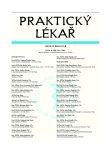The gap between the objective and the subjective, patient stress, psychosomatics
Authors:
F. Irmiš
Authors‘ workplace:
Psychiatrie a psychosomatika, Praha
Published in:
Prakt. Lék. 2010; 90(6): 358-362
Category:
Of different specialties
Overview
The article describes stress to patients caused by difficulties in diagnosis through objective diagnostic methods and incomplete information on the course of their disease/illness. A physician’s opinion may not correspond with the patient’s experience. A communication failure occurs. There is a range of discrepancies (dissociation) between clinical picture, subjective complaints and examination methods. A better understanding may be achieved through qualitative-quantitative analysis from the objective and subjective points of view, including evaluation of maximal and minimal worsening of the disease, and reactions to various stress. Latent, chronic, atypical, functional, psychosomatic diseases are discussed from the viewpoint of therapy and inborn (constitutional) disposition, influenced by stress.
Key words:
dissociation between subjective and objective, patient stress, communication breakdown, patient’s experience, atypical and psychosomatic disease.
Sources
1. Baštecký, J., Šavlík, J., Šimek, J. Psychosomatická medicína. Praha: Grada Avicenum, 1993, s. 363.
2. Beran, J. Základy psychoterapie pro lékaře. Praha: Grada Publishing, 2001, s. 156.
3. Frankl, V.E. Teorie a terapie neuróz. Praha: Grada, 1999, s. 171.
4. Hamer, D., Copeland, P. Geny a osobnosti. Praha: Portál, 2003, s. 252.
5. Haškovcová, H. Práva Pacientů. Komentované vydání. Havířov: Nakladatelství Aleny Krtilové, 1996, s. 176.
6. Honzák, R. Komunikační pasti. Praha: Galén, 1999, s. 165.
7. Chromý, K., Honzák, R. a kol. Somatizace a funkční poruchy. Praha: Grada Publishing, 2005, s. 216.
8. Irmiš, F. Výroky lékařů, které mohou pacienta stresovat. Prakt. Lék. 2006, 86, s. 695-697.
9. Irmiš, F. Individuální norma a kvalitativně-kvantitativní dynamika nemoci: mezi „objektivním“ a „subjektivním“. Prakt. Lék. 2004, 84, s. 104-107.
10. Irmiš, F. Temperament a autonomní nervový systém. Diagnostika, psychosomatika, konstituce, psychofyziologie. Praha: Galén 2007, s. 204.
11. Kaplan, S.H., Greenfield, S., Gandek, B. et al. Characteristic of physicians with participatory decision-making styles. Ann. Inter. Med. 1996, 124(5), p. 497-504.
12. Kirch, W. a kol. Chybné diagnózy ve vnitřním lékařství. Martin: Vydavatelstvo Osveta, 1995, s. 339.
13. Koukolík, F. Nečekaná pitevní diagnóza prvního typu. In: Kde se stala chyba? Kazuistiky I. (ed. Honzák, R.). Praha: Galén, 1997, s. 11-23.
14. Křivohlavý, J. Rozhovor lékaře s pacientem. Brno: Institut pro další vzdělávání pracovníků ve zdravotnictví, 1995.
15. Mareš, J. Pacientovo subjektivní pojetí zdraví a nemoci. Prakt. Lék. 2006, 86, s. 109-114.
16. Pavlát, J. Obtížný pacient. Psychiatr. pro Praxi, 2000, 2, s. 47-50.
17. Sanson-Fischer, R., Maguire, R. Should skills in communicating with patients be taught in medical school? Lancet 1980, 316(8193), p. 523-526.
18. Simonton, O.C., Mathews-Simonton, S., Creighton, J.L. Návrat ke zdraví. Praha: Nakladatelství Radost 1994, s. 178.
19. Strauss, A., Corbinová, J. Základy kvalitativního výzkumu. Boskovice: Albert 1999, s 202.
20. Tate, P. Příručka komunikace pro lékaře. Jak získat důvěru pacienta. Praha: Grada Publishing, 2005, s. 164.
21. Tournier, P. Silní a slabí. Praha: Návrat domů, 1995, s. 195.
22. Trapková, L., Chvála, V. Rodinná terapie psychosomatických poruch. Praha: Portál, 2004, s. 227.
23. Vácha, J. Problém normálnosti v biologii a lékařství. Praha: Avicenum, 1980, s. 180.
Labels
General practitioner for children and adolescents General practitioner for adultsArticle was published in
General Practitioner

2010 Issue 6
Most read in this issue
- Adverse effects of non-steroidal anti-inflammatory drugs
- The gap between the objective and the subjective, patient stress, psychosomatics
- Supervision as a method of prevention of burn-out syndrome in health care professionals
- The etiology and new clinical-etiology-anatomy-pathophysiology (CEAP) classification of extremitovascular ischemic disease
